Roman art: 27 BC to 117 AD
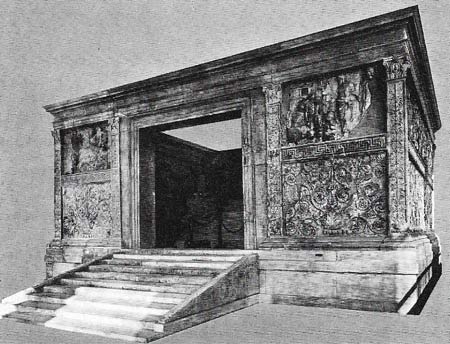
The unsurpassed richness of the reliefs of the Altar of Augustan Peace symbolize, through a synthesis of propaganda and art, the Augustan ideals of victory, piety and peace. They combine a decorative pattern with a narrative frieze, depicting Augustus, his family and officials.
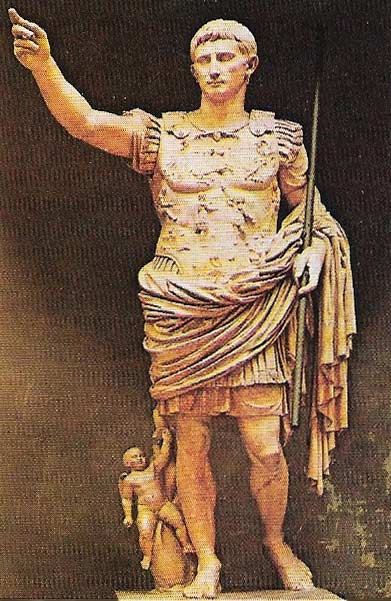
This powerful representation of the ageless Augustus shows him in a cuirass decorated with images commemorating a victory over the Parthians. Although based on a Greek statue, its modified stance and forcefulness of head mark it as a truly Roman creation in concept and style.
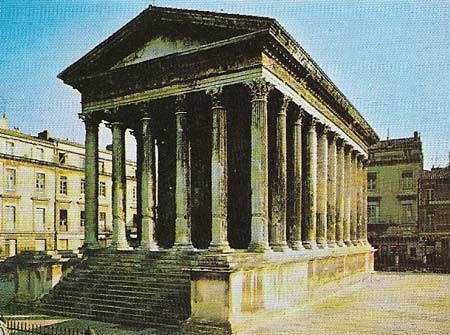
In the Corinthian-style Maison Carrée, Nîmes, Hellenistic architecture is modified to accommodate the special requirements of the Roman religion, which placed emphasis on the interior rather than the exterior of a temple. The top two of a flight of steps form a threshold below the cella (the enclosed portion), the width of which equals the length of the portico. The colonnade is continued round the outside of the cella but, unlike that on a Greek temple, is embedded in solid walls. Modelled on prototypes in Rome it is one of the best examples of Roman temple architecture of the Augustan age.

The Flavian amphitheatre in Rome – the Colosseum – was conceived by the Emperor Vespasian and constructed between AD 72 and 81. It was one of the greatest Roman architectural achievements and served as a model for amphitheatres throughout the empire. Its outer framework and basic interior structure were composed of gigantic blocks of travertine (a kind of hear limestone), the remainder being built of softer stone and concrete, largely faced with marble. Rising 45.7 meters (150 feet) in four stories the arcaded facade included columns of all three orders – Doric, Ionic and Corinthian – with the upper part decorated with numerous statues. As many as 45,000 spectators, who gained admittance through 80 entrances, sat on tiers of marble seats arranged by class. They were protected from sun and rain by a movable awning.
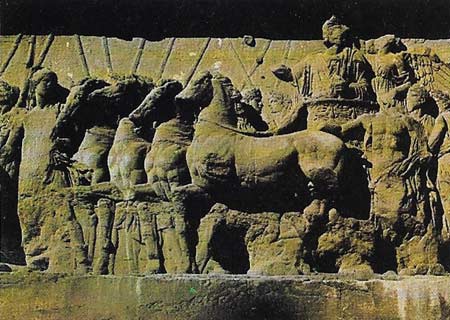
Titus' military achievements are commemorated on the reliefs of the Arch of Titus, which depicts his triumphal return from the sack of Jerusalem in AD 70. The arch was built by Domitian.
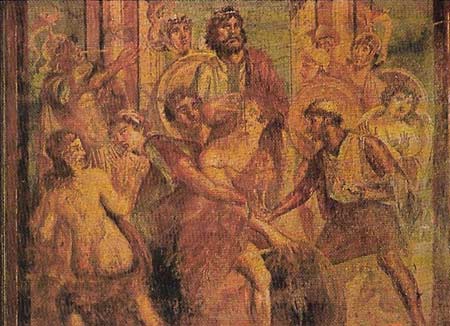
This Pompeian painting shows a mastery in the use of color, representation of perspective, attention to detail and appreciation of architectural interiors. These were hallmarks of the painter's art, in the 1st century AD.
Until recently, Roman art was regarded as the bridge between the art of Greece and that of the Middle Ages; largely decadent, it provided a continuity of tradition but because it derived almost certainly from Hellenic models, it offered few original contributions. Now it is widely accepted that, while assimilating Greek styles and techniques, Roman art in fact greatly modified and developed them. Rome remodelled Hellenic art to express imperial ideals – the power of the ruler and his role as patron, benefactor and protector of an orderly society.
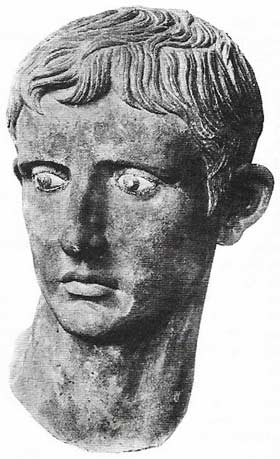 |
>
| A bronze head of Augustus first emperor of Rome, was found in Meroe, Sudan. Once part of a colossal statue, it characterizes the politically significant art of portraiture during the Roman Republic and after. In some ways idealized, it depicts Augustus in the prime of life. In fact it was made at the time of his death at the age of 76. It departs from Greek portraiture in conveying the strength of the man who symbolized the power and unity of the empire. Julian, in his letter to Theodorus, explained the correct attitude to imperial portraits: "He who loves the emperor delights to see the emperor's statues."
|
Greek art and artists in Rome
The Romans themselves acknowledged the superiority of Greek art and architecture and from the time of the first contacts between the two cultures a steady flow of sculptors, architects and craftsmen in all fields entered the Roman Empire from the cast in order to satisfy the increasing demands of her citizens. As early as 268 BC Greek artists had designed the Roman coinage, while as Rome conquered the Greek world huge quantities of booty, from small decorative objects to almost entire buildings, were taken to Rome. (In 187 BC, Marcus Fulvius Nubitor acquired 285 bronze and 230 marble statues during his conquests in Aetolia, while in 168 BC Aemilius Paulus seized no fewer than 250 wagon-loads of art treasures from Macedonia.) Greek artists were employed to copy and even make pastiches of these works to meet an avid demand.
Different aesthetic attitudes and techniques separated Greek art from Roman, Greek art was produced by individuals whose names are recorded – Phidias' Parthenon, for example. Roman art was almost always anonymous, because the patron who commissioned it was of greater importance than the artisan who created it; so it is that we have the Arch of Constantine, the Baths of Caracalla and Hadrian's Wall.
By the age of Augustus (63 BC–AD 14) Greek (and to some extent Etruscan) influences had been assimilated and most architectural forms were established. Roman architecture offers an immense diversity of types and regional styles using a rich variety of local materials. Among its chief characteristics are the development of the columnar and trabeated (post and lintel) design of the Greeks and continuation, with modifications, of the three Greek orders (sometimes all in the same building, as in the Colosseum). To them the Romans added the Tuscan, a variant of the Doric, and Composite, a combination of Ionic and Corinthian. All the orders were used decoratively and the elaborate Corinthian, the least popular with the Greeks, became the favourite under the Romans. Similarly, interior decoration using marble and alabaster, paintings and mosaics was highly developed by the Romans, who placed a greater emphasis on interiors than did the Greeks. Added to this increased visual richness was a far greater variety of forms – Roman urban life prompted the demand for such structures as baths, theatres and amphitheaters, bridges, viaducts and aqueducts and multi-storied domestic buildings. Many of them were on a massive scale and were built rapidly, thanks to the Romans' introduction of concrete and brick.
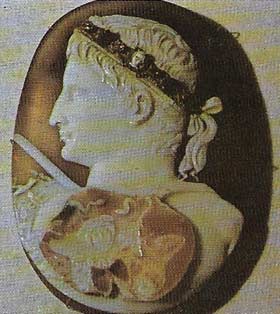 |
>
| Augustan art was employed as a propaganda tool. In this cameo the ageless Augustus is represented as the revered messianic leader of a cultured and refined Roman society.
|
The political emphasis of Roman art was especially obvious under Augustus who, in keeping with his role as bringer of peace and prosperity to the empire, was himself portrayed as a pure, magnanimous, handsome and ageless ruler; the serene formality and diverse imagery of Augustan art is summarized in the reliefs of the Ara Pacis (the Altar of Peace). In his program of urban expansion he restored numerous buildings (82 temples in Rome alone) and built many others, including the magnificent temple of Mars Ultor, the Forum Augusti and the Maison Carre, Nimes.
Imperial patronage
The Augustan age had established the range of Roman architectural styles. Subsequent trends reflected the individual preferences of rulers and emphasized the intimacy of the link between the imperial patron and the objects he commissioned. Under Nero and Flavians, for example, artists were given a freer hand and many extravagant works such as buildings with exotic octagonal, circular or oval rooms were constructed. Nero's sumptuous Golden Palace in Rome was a notable example. After this flamboyant interlude the Trajan instigated a reaction in which utilitarian structures predominated.
Realism and portraiture
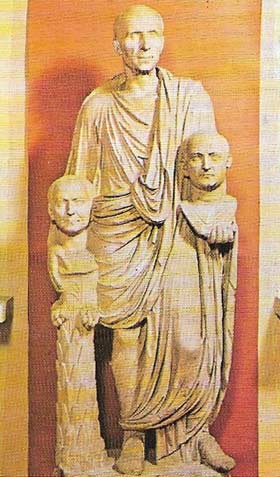 |
| Roman portraiture developed out of the custom of producing wax death-masks for funerary processions. Both this patrician and the busts of his ancestors show identifiable individuals rather than types.
|
Portraiture, one of the major achievements of Roman art, developed throughout this period. It moved away from the idealism seen in the official propaganda portraits of Augustus toward a remarkable, almost brutal, realism under such later rulers as Claudius and Nero. Greek artists sought to transcend the individual in a quest for universal truths, while the Romans were concerned with accurate likenesses. The contrast between idealism and realism is seen particularly in portrait busts and also in the narrative reliefs on the Arch of Titus and Trajan's Column.
Roman painting, known chiefly from examples of Pompeii, was largely derived from Greek, but developed along new lines. Urban Romans maintained their traditional connection with their rural background by favouring landscapes, which became increasingly theatrical and impressive.
